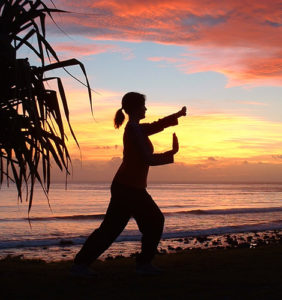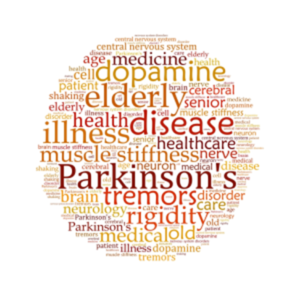
I’ve often wondered what people think when they hear the term Tai Chi for the first time. “What is that? Some kind of new drink?” No, Tai Chi has nothing to do with Chai (tea). Rather, Tai Chi is an ancient Chinese form of exercise, often described as ‘meditation in motion’. Its gentle, flowing movements comprise exercise, stretching and balance. Numerous studies have shown that practicing Tai Chi improves balance, fitness, muscular strength, flexibility, relieves stress and anxiety and improves quality of life.
Disclaimer: Again, I am not a physician! This blog simply details my own personal experiences and thoughts. If you have a medical condition, or anything that might limit you in any way, please consult your own physician and/or neurologist before beginning any new exercise routine!
 Tai Chi and Parkinson’s Disease
Tai Chi and Parkinson’s Disease There have been many studies done that show people with Parkinson’s (PD) who regularly practice Tai Chi experience significant benefits, some of which include:
There have been many studies done that show people with Parkinson’s (PD) who regularly practice Tai Chi experience significant benefits, some of which include:
- Enhanced flexibility, balance and agility
- More energy and stamina
- Reduced blood pressure
- Better mood, with less depression, stress and anxiety
- Greater muscle strength
Studies have also shown that practicing Tai Chi improves balance and gait, thus resulting in fewer falls. According to one study, after six months, people who had been practicing Tai Chi were able to lean farther forward or backward without stumbling or falling compared to those who had been doing resistance training or stretching only. [2] Why is that important? Falling is something that happens frequently in people with PD as the disease advances; usually resulting in injury and hospitalization. Avoiding falls, therefore, is one of the most important things a PD patient can do.
![]()
But It’s Not Just For Parkies… Everyone Can Benefit! It’s also important to note that most, if not all, of these same benefits apply to anyone practicing Tai Chi, regardless if they have Parkinson’s or not! Research at the University of Toronto by Dahong Zhou, MD, notes that Tai Chi in general reduces stress levels and emotional problems while improving “concentration, attention, composure, self confidence, and self control”. He indicates that Tai Chi generally reduces hypertension, relieves chronic headaches, dizziness and insomnia, has benefits for people suffering with mild arthritis and rheumatism, improves breathing and blood circulation and is “an excellent exercise for the mind.” His research shows that due to the low intensity of most forms of Tai Chi, it does not lead to fatigue or stress of the muscles and joints and is therefore considered to be safe for people of all ages. [3] joints and is therefore considered to be safe for people of all ages. [3]
But It’s Not Just For Parkies… Everyone Can Benefit! It’s also important to note that most, if not all, of these same benefits apply to anyone practicing Tai Chi, regardless if they have Parkinson’s or not! Research at the University of Toronto by Dahong Zhou, MD, notes that Tai Chi in general reduces stress levels and emotional problems while improving “concentration, attention, composure, self confidence, and self control”. He indicates that Tai Chi generally reduces hypertension, relieves chronic headaches, dizziness and insomnia, has benefits for people suffering with mild arthritis and rheumatism, improves breathing and blood circulation and is “an excellent exercise for the mind.” His research shows that due to the low intensity of most forms of Tai Chi, it does not lead to fatigue or stress of the muscles and joints and is therefore considered to be safe for people of all ages. [3] joints and is therefore considered to be safe for people of all ages. [3]![]()
Finally, like Parkinson’s patients, Tai Chi has been shown to reduce the risk of falls in older people – which can be just as catastrophic. Avoiding falls helps lead to a healthier life. And we can all use that!
Tai Chi Today
There are many forms and styles of Tai Chi available today. All of these date back to the start of Tai Chi in ancient China. Originally Tai Chi was an internal Chinese martial art practiced for both its defense training and its health benefits. As a result, a multitude of training forms exist, both traditional and modern, which correspond to those aims with differing emphasis.
Though originally conceived as a martial art, today it has developed a worldwide following of people, often with little or no interest in martial training, but rather for its benefits to personal health – both physical, internal and mental. Tai Chi is especially known for being practiced with relatively slow movements.
 Taoist Tai Chi®
Taoist Tai Chi®
The form I practice (and the one I recommend) is Taoist Tai Chi®. Taoist Tai Chi® was founded by Master Moy Lin Shin (1931 – 1998). During his childhood, Master Moy was beset by many health issues. To aid in his recovery, Master Moy began practicing Tai Chi and meditation under Tai Chi teachers and masters and regained his health. Wanting to make this healthy art style available to others, he created a series of 108 moves specifically designed with health benefits in mind. This is the Taoist Tai Chi® arts practiced today. Later on, Master Moy immigrated to Canada, where he devoted the rest of his life to fulfilling the aim to help people restore and maintain their physical, mental and spiritual well being through the practice of the Taoist Tai Chi® arts. This is the main reason why I joined and practice this style of Tai Chi, because of Master Moy’s design of this style for health benefits; and also because of his devotion to helping others become more healthy.
 Hold It, Bub – Did you say 108 moves?!?
Hold It, Bub – Did you say 108 moves?!?
Most forms of Tai Chi consist of a number of different moves, comprising a ‘set‘. Depending on the form, the number of moves can range from a relatively small number to a larger one. The Taoist Tai Chi® form that I practice consists of a total of 108 moves. And yes, that was my first thought too – how in the world am I going to learn 108 moves?? It does sound like a lot of moves to remember; but it’s easier than you think. In my case, that’s because:
- A lot of the moves throughout the set are repeated – so you really don’t have to learn 108 totally separate This is probably true in most other forms of Tai Chi as well.
- The first 17 moves (which I found to be easily learned) can be repeated over and over to give you some of the same health benefits that the full 108 move set does.
If I find myself with a few minutes here and there during the day, I can do the first 17-move set simply to get some exercise and to relax.
And I am by far no expert! It takes time and practice. Even after a year and a half, I’m still learning the moves and refining my style – because it is a continuing process. But I’ve found our instructors and leaders to be very patient with each and every student, thus helping each one to learn and not get overwhelmed.
Reference: Click here to see a YouTube video of Master Moy Lin Shin demonstrating the full 108 moves of Taoist Tai Chi®
“Tai Chi Tom”
I’ve been interested in Tai Chi since I was a young adult. I was always amazed when I saw people doing the soft, flowing moves, and wondered how hard it was to learn. That, unfortunately, is about as far as I went with it, until I was diagnosed with Parkinson’s.
After that, during my research, I began noticing all the articles about the health benefits of Tai Chi; so in spring of 2015, after researching what organizations and classes were available in my locality, I went to a Taoist Tai Chi® open house. Finally, in the fall of 2015, I enrolled in my first beginner class! After going to two (yes two) beginner classes, I have continued practicing the art while attending the more advanced class (called the ‘continuing’ class in Taoist Tai Chi®). As I mentioned before, the one thing about Tai Chi I really like is that you are always learning – refining the moves, and learning new techniques.
As far as “Tai Chi Tom” goes… well, I kinda “got” that title when I ‘drafted’ my Tai Chi group to go with me to a 2016 Parkinson’s Walk here in town. Our group gave a demo of Taoist Tai Chi® out on the grass, while I was drafted to give a small speech to the crowd at the event about my story and how Tai Chi has helped me. Hence, the name ‘Tai Chi Tom‘! (kinda flows off the tongue, doesn’t it?)
 What Tai Chi Has Done For Me
What Tai Chi Has Done For Me
In my case, I can say with honesty that Tai Chi has helped me tremendously during this journey with PD. Because of Tai Chi, I am much more balanced than I would be without it. As an example, about 6 months after I started Tai Chi, I had a PD evaluation by a Physical Therapist (PT). She was amazed at my balance and stability (even with the disease) – I told her that it was because I had been learning Tai Chi. She was so impressed by how Tai Chi helped me, she was going to recommend it for some of her patients! So you see, it really does help!
Other things I’ve noticed: My joints are more loose and open, and I just physically feel… well, better! Plus, doing the set has helped my mental state, with me being more calm and collected. And even though some folks may look at the slow flowing moves and say that can’t be exercise, I can attest that it truly is! Many a time I have finished a Tai Chi set or exercise only to find myself sweating and out of breath!
Another benefit for me, and for any PD patient, is that it gets you out socially; and that is important for all of us, especially as the disease progresses. I have not only learned Tai Chi, but I have made friends, and participated in events sponsored by our group – and they, in turn, have helped me and the Parkinson’s community (by freely giving up some time on a weekend to demo Tai Chi at the aforementioned Parkinson’s walk!) It is important for us with this disease to get out and live, and not be a hermit, for that will only quicken the disease progress.

And besides, no one likes a crabby hermit!!
 Try It, You’ll Like It! I highly recommend you give Tai Chi a try, regardless of whether you have Parkinson’s or not. The health benefits have been shown, and I believe, like me, you will find it a great exercise and addition for your health! So, if you decide to give it a try, here are my top 7 recommendations for you to remember:
Try It, You’ll Like It! I highly recommend you give Tai Chi a try, regardless of whether you have Parkinson’s or not. The health benefits have been shown, and I believe, like me, you will find it a great exercise and addition for your health! So, if you decide to give it a try, here are my top 7 recommendations for you to remember:

Tom’s Top 7 Recommendations for New Tai Chi-ers
- Choose a Tai Chi organization or class that is specifically tailored for health benefits. As I mentioned there are lots of styles and forms of Tai Chi out there. I recommend you find one that is health oriented since that style will give you the most benefits. This is especially true if you have an underlying condition such as PD. If available in your town, I would suggest the Taoist Tai Chi® Society since that is the style I use and feel (my personal opinion only) provides the best health benefits. Taoist Tai Chi® has locations internationally in 26 countries; and in the US alone, the Taoist Tai Chi® arts are taught in 28 states and the District of Columbia. You can find their US locations at their website. But whatever style or class you choose, do your research ahead of time and find what’s best for you!
- If offered, take the beginner or starting class TWICE. I say this because I did it and found it helped me to better learn the moves. The first time through I was simply trying to remember and mimic the moves; the second time I was able to concentrate more on each move in itself and the technique involved.
- Continue attending the next class level(s). Once you finish the beginner class(s), don’t just stop there – go on to the next level classes. Intermediate/Advanced (or in Taoist Tai Chi® ‘Continuing’) classes go into more depth about each move and allow you to refine and become even better with your routine; which in turn can make it even more healthy.
- Practice regularly. Remember this is a commitment – if you want the health benefits you have to practice!
- Know your limitations. If you have a condition such as Parkinson’s, know when to stop and rest, and don’t overdo it, especially at the beginning. Your stamina and strength will improve as you practice!
- If you have an underlying condition (such as PD), and feel comfortable about it, I would highly recommend you let your instructor know about it. You don’t have to do this in front of the class – in fact, you might want to attend a couple of times first to gauge your instructor. But if you then feel comfortable, take him or her aside and let them know you what your condition is. It will, in most cases, help them tailor their instruction to your condition, and not overwork you. I know this can be a scary thing to do, but I did it with my instructor and she was completely understanding; and I know it helped her teach me better by knowing my limitations due to Parkinson’s.
- Have fun! It’s work, yes; it’s exercise, yes; but it is also fun practicing Tai Chi, along with getting out and enjoying time with other people. Don’t make it a task you have to do, rather make it a task you want to do!
Probably the best way to find a Tai Chi location in or near your city is by checking the internet, your local Yellow Pages, or with your doctor, neurologist, or physical therapist. It can be part of a national or international organization, run as part of physical therapy (if you are a parkie) or by your local YMCA or gym. Locations may offer open houses throughout the year; if so you can attend one of these and see for yourself what Tai Chi is all about. I would encourage you to join a class so you too can begin enjoying the health benefits of Tai Chi! See you there!!
Tai Chi ![]()
References [1] [Mayo Clinic] Exercise: When to Check With Your Doctor [2] WebMD] Tai Chi Improves Symptoms of Parkinson’s Disease – Study: Tai Chi Leads to Smoother, Steadier Movements, Longer Strides, and Fewer Falls Compared to Other Types of Exercise [3] Zhou, Dahong, M.D.: The Chinese Exercise Book, pages 19-22. Hartley & Marks Publishing, 1984 [via Wikipedia] ISBN 0-88179-005-2?References to Studies/Other Articles Regarding Tai Chi Benefits A Comprehensive Review of Health Benefits of Qigong and Tai Chi Tai chi improves balance and motor control in Parkinson’s disease Study: Tai Chi improves balance in Parkinson’s Patients



